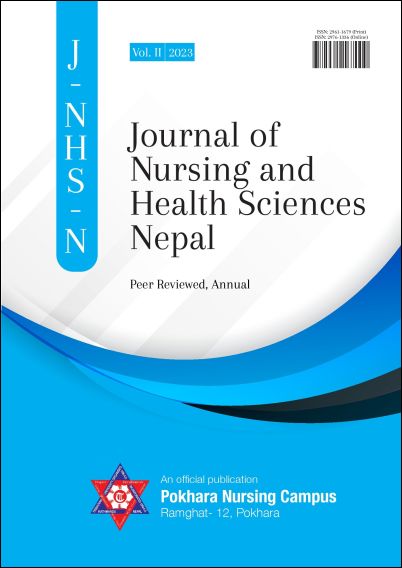Perceived Risk of COVID-19 among Nurses Working in a Tertiary Level Hospital of Kathmandu: A Cross-Sectional Descriptive Study
DOI:
https://doi.org/10.3126/jnhsn.v2i1.66462Keywords:
Perceived risk, COVID-19, nurse, hospitalAbstract
Introduction: Nurses are at higher risk of contracting and transmitting the novel coronavirus because of their work exposure. Perceived risk plays a major role in controlling COVID-19 propagation in a healthcare setting. The objective of this study was to find out the perceived risk of COVID-19 among nurses working in a tertiary-level hospital.
Methods: A cross-sectional descriptive design was adopted. One hundred forty-four nurses were selected through a simple random sampling technique. A self-administered structured questionnaire was used for data collection. Collected data were entered into Epi-data version 3.1 and transported into Statistical Package for Social Science (SPSS) version 16 for further analysis.
Results: One hundred forty-four nurses participated in the study. The age group ranged from 21-54 years (mean ± SD = 28.12 ± 5.045). More than half [76 (52.8%)] were unmarried. Almost all respondents [135(93.7%)] were staff nurses. One-hundred twenty (83.3%) had not taken infection prevention and control training. Almost all respondents [139(96.5%)] had no chronic illness. Only, twenty respondents (3.5%) had maternal-related health conditions. Half of the respondents [75(52.1%)] were living with vulnerable family members. Most of the respondents [125(86.8%)] had a high level of perceived risk of COVID-19.
Conclusions: The study highlights the high level of the perceived risk of COVID-19 among nurses. Most of the nurses were worried about getting COVID-19 and transmission to their loved one’s health. High levels of perceived risks lead to less effective healthcare services therefore, there is a need for appropriate intervention to address nurses’ problems in crisis time.
Downloads
Downloads
Published
How to Cite
Issue
Section
License
Copyright (c) 2023 The Author(s)

This work is licensed under a Creative Commons Attribution 4.0 International License.
This license enables reusers to distribute, remix, adapt, and build upon the material in any medium or format, so long as attribution is given to the creator. The license allows for commercial use.




